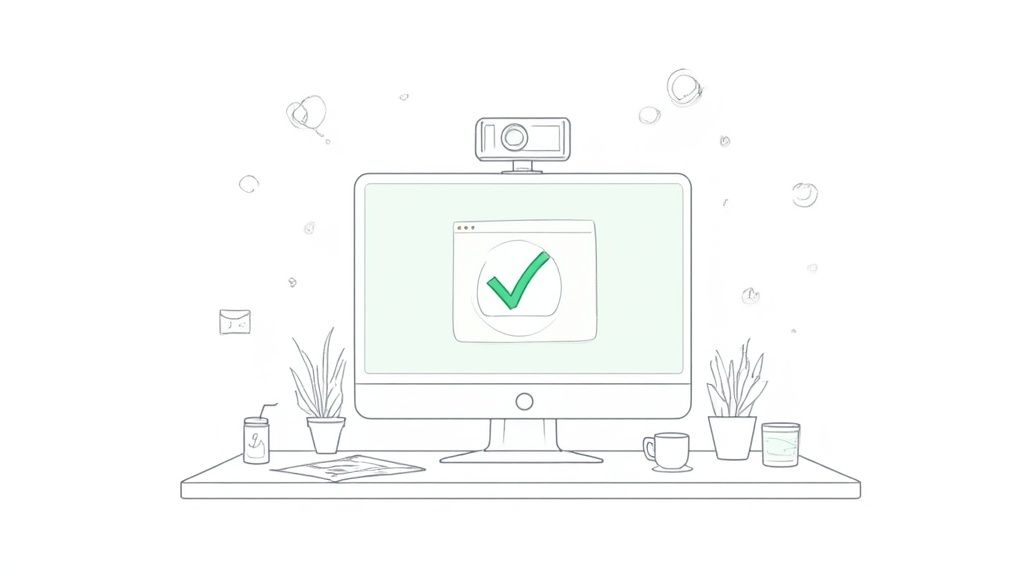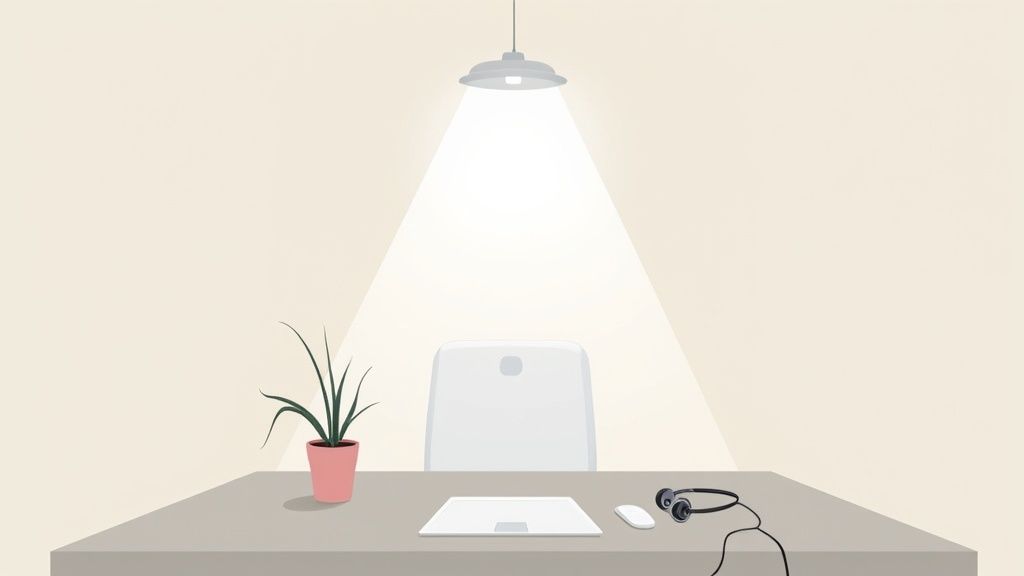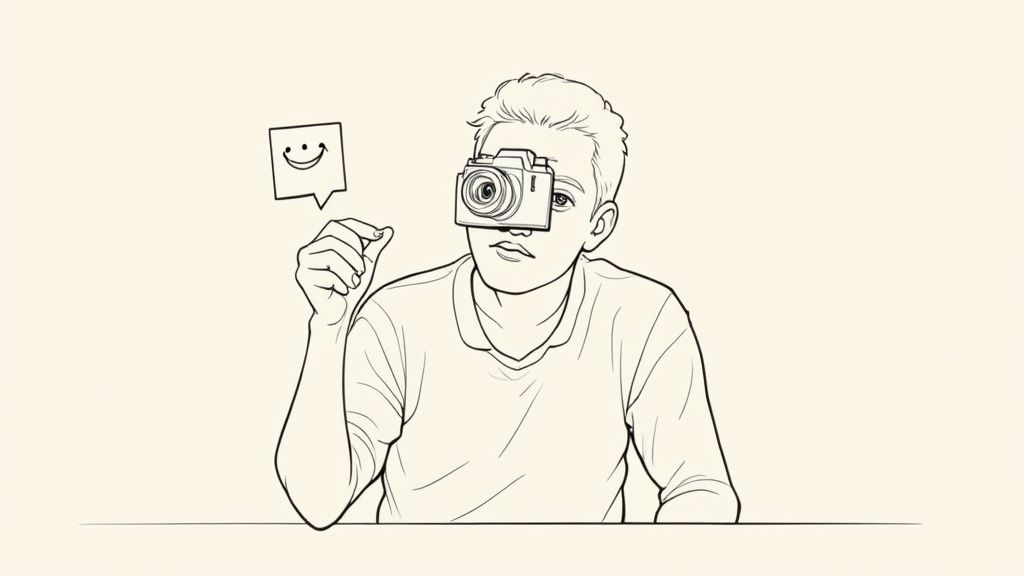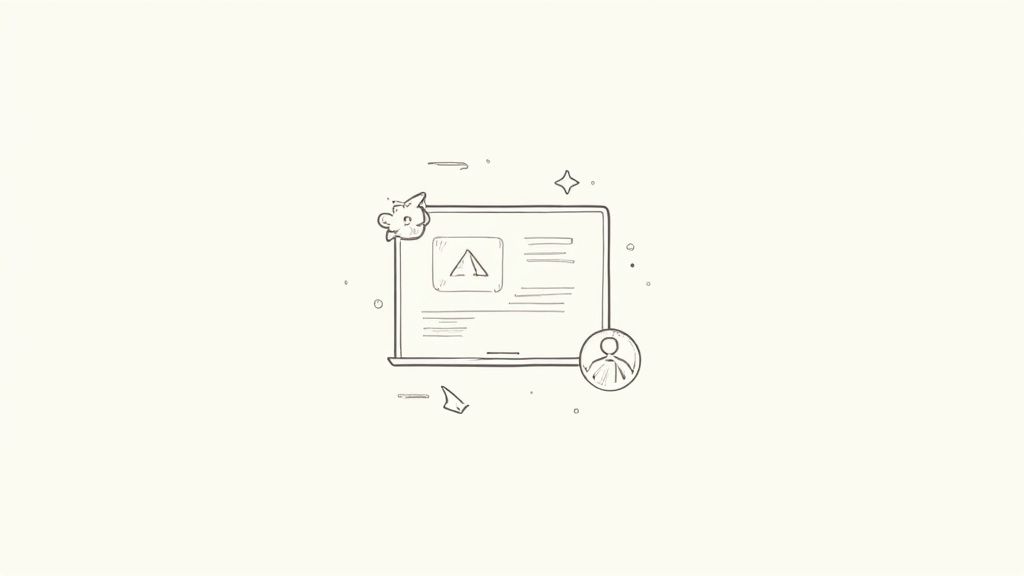
Top Remote Interview Tips to Help You Succeed
Published
Level Up Your Virtual Interview Game
Remote interviews are the new norm, and succeeding requires more than just strong answers. This listicle provides seven essential remote interview tips to help you impress potential employers and land your dream remote role. Learn how to create a professional online presence, troubleshoot your tech, master virtual body language, and leverage digital tools effectively. These tips are crucial for anyone seeking remote opportunities, from influencer marketing professionals and brand strategists to digital and social media specialists. We'll cover everything from tech setup to remote-specific responses, giving you the edge in your next virtual interview.
1. Test Your Technology in Advance
Acing a remote interview starts long before the scheduled time – it begins with meticulous preparation, and at the top of that list is ensuring your technology is flawless. "Testing your technology in advance" isn't just a suggestion; it's a critical step for any successful remote interview. This involves comprehensively checking your internet connection, camera, microphone, and the specific video conferencing platform being used. Technical glitches during the interview can disrupt the flow, create unnecessary stress, and project an unprofessional image to potential employers. A smooth, technically sound interview allows you to focus on showcasing your skills and experience, rather than troubleshooting connectivity issues.

This crucial first step encompasses several key features: equipment checks (camera, microphone, headphones), software familiarization (knowing the ins and outs of the video platform), connectivity tests (ensuring stable internet speed), and backup planning (having alternative devices and solutions ready). For instance, a software engineer candidate, anticipating a remote interview, conducted a full system test. This proactive approach revealed a malfunctioning microphone. Fortunately, with time to spare, they borrowed a quality headset from a friend, averting a potential disaster during the actual interview. This example highlights why testing your tech in advance deserves its place as a top remote interview tip.
Pros of Testing Your Technology:
- Reduces risk of technical disruptions: Minimizes the chances of unexpected issues during the interview.
- Projects professionalism: Demonstrates preparedness and attention to detail, leaving a positive impression on the interviewer.
- Allows you to focus on interview content: Eliminates the distraction of technical difficulties, allowing you to concentrate on answering questions effectively.
Cons of Testing Your Technology:
- Requires time investment before the interview: Setting aside dedicated time for testing is essential, but can be challenging for busy schedules.
- May need to upgrade equipment or internet service: In some cases, testing may reveal the need for better equipment or a faster internet connection, which can involve additional costs.
Actionable Tips for Testing Your Technology:
- Test your setup at least 24 hours before the interview: This provides ample time to address any potential issues.
- Join the meeting room 10-15 minutes early: Allows you to ensure everything is working correctly and gives you a few moments to compose yourself.
- Have a backup device ready (phone or tablet): In case of primary device failure, a backup ensures the interview can proceed.
- Know how to quickly troubleshoot common issues: Familiarize yourself with basic troubleshooting steps for your chosen video platform.
- Download any required software and create accounts beforehand: Avoid last-minute scrambling by installing necessary software and creating accounts well in advance.
Whether you're an influencer marketing professional, a digital strategist, a job seeker, or a recruiter, mastering the art of the remote interview is crucial in today's digital landscape. Implementing this first tip – thoroughly testing your technology – is a significant step towards a successful and stress-free remote interview experience. By proactively addressing potential technical hurdles, you can confidently present yourself and focus on what truly matters: showcasing your skills and landing your dream opportunity.
2. Create a Professional Environment
Acing a remote interview hinges on more than just your answers; it's about presenting a polished and professional image. Your interview environment speaks volumes before you even utter a word. This means creating a dedicated space that minimizes distractions and maximizes your interviewer's confidence in your abilities. A well-chosen setup shows you’re serious about the opportunity and take pride in your work, crucial aspects for any role, especially in remote positions. This is why establishing a professional environment is a critical remote interview tip.

Controlling your background, lighting, and noise level is paramount. A cluttered or distracting background can shift the interviewer's focus away from your qualifications. Similarly, poor lighting can make you appear shadowy and unprofessional, while background noise can disrupt the flow of conversation. Think of your interview space as a stage: you want the spotlight on you and your expertise.
Features of a Professional Remote Interview Setup:
- Controlled Background: A neutral, uncluttered background is ideal. A blank wall, a tidy bookshelf, or a tastefully decorated space works well. Consider using a virtual background if your physical space is less than ideal, but ensure it's not distracting.
- Proper Lighting: Front-facing, natural light is best. Avoid backlighting, which can cast you in shadow. A desk lamp can supplement natural light if needed.
- Noise Management: Inform household members about your interview time to minimize interruptions. Close windows to block out street noise, and consider using noise-cancelling headphones.
- Professional Appearance: Dress as you would for an in-person interview. This demonstrates respect for the interviewer and the opportunity.
Pros:
- Creates a Positive First Impression: A professional setting instantly conveys competence and seriousness.
- Minimizes Distractions: A controlled environment allows you and the interviewer to focus on the conversation.
- Demonstrates Preparation and Professionalism: Taking the time to create a dedicated interview space shows you are organized and committed.
Cons:
- May be Challenging in Shared Living Spaces: Finding privacy and quiet can be difficult in shared accommodations. Get creative and communicate your needs to those you live with.
- Might Require Temporary Rearrangement of Your Space: You may need to temporarily move furniture or adjust your setup to achieve the desired professional look.
Example: A marketing candidate who set up near a window with natural light and a neutral background received specific positive feedback about their professional setup, demonstrating the tangible impact of this preparation. This not only boosted their confidence but also signaled their attention to detail, a valuable trait in marketing roles.
Actionable Tips for Your Remote Interview:
- Position your camera at eye level: This creates a more natural and engaging interaction.
- Use front-facing lighting to avoid shadows: Ensure your face is well-lit and clearly visible.
- Remove personal items from view or use a virtual background if appropriate: Maintain a professional and uncluttered background.
- Inform household members about your interview time: Minimize interruptions and potential distractions.
- Consider using noise-cancelling headphones: This ensures clear communication and minimizes background noise.
- Check what appears in your camera view before starting: Do a final visual check to confirm everything looks professional and presentable.
This approach is relevant for any remote interview, regardless of the industry. It's particularly valuable for influencer marketing professionals, digital and social media specialists, brand and content strategists, and anyone seeking remote opportunities, as it reflects the ability to manage a professional online presence, a key skill in these fields. By following these tips, inspired by experts like LinkedIn career advisors and remote work influencers like Lisette Sutherland, you can create a positive and productive interview experience that increases your chances of landing your dream remote job.
3. Practice Virtual Body Language
Mastering virtual body language is crucial for successful remote interviews. In a traditional face-to-face setting, we communicate a lot through subtle physical cues. Since remote interviews limit this interaction to what's visible on camera, you must be intentional about how you present yourself visually. Effective virtual body language includes maintaining "digital eye contact" by looking at the camera, sitting with good posture, and using appropriate facial expressions and hand gestures. This translates to appearing engaged, confident, and professional, even through a screen. This skill is particularly important for roles in influencer marketing, social media, and content strategy where communication is key.

This deserves a spot on the list of top remote interview tips because it directly addresses the unique challenges of digital communication. While many focus on technical aspects or interview content, virtual body language significantly impacts how your responses are perceived. Features like consistent digital eye contact, visible enthusiasm, and camera-friendly gestures build connection and trust with the interviewer, despite the physical distance. For example, a candidate interviewing for a customer service position who practiced looking directly at the camera, instead of the interviewer’s image on the screen, was rated significantly higher for their apparent confidence and connection. This is a powerful testament to the importance of this often-overlooked aspect of remote interviewing.
Pros:
- Builds connection despite physical distance: Looking at the camera creates the illusion of direct eye contact, fostering a stronger connection with the interviewer.
- Demonstrates engagement and confidence: Good posture and animated expressions convey enthusiasm and self-assuredness.
- Compensates for limited non-verbal cues: Intentional body language clarifies your messages and prevents misinterpretations.
Cons:
- Can feel unnatural at first: Speaking to a camera instead of a person takes practice and conscious effort.
- Requires conscious effort and practice: Mastering these techniques requires preparation and dedicated practice.
Tips for Improving Your Virtual Body Language:
- Simulate Eye Contact: Place a small sticky note with a smiley face near your camera as a visual reminder to look there. Position your video conferencing window close to your camera to minimize the difference in eye-line.
- Practice, Practice, Practice: Before your interview, practice speaking to the camera to get comfortable with this new mode of communication. Record yourself and review the footage to identify areas for improvement.
- Use Deliberate Gestures: Use nodding to show understanding and agreement. Keep hand gestures within the camera frame and avoid excessive or distracting movements.
- Project Energy and Enthusiasm: Since subtle cues can be lost on camera, maintain a slightly exaggerated level of energy and expression to ensure your enthusiasm translates effectively. This is especially important for marketing and influencer-related roles where projecting personality is essential.
By implementing these tips, you can leverage virtual body language to your advantage and make a strong, positive impression on potential employers. This practice, popularized by communication experts like Vanessa Van Edwards and body language specialist Mark Bowden, is a critical tool for anyone navigating the world of remote work, especially those in competitive fields like influencer marketing and digital strategy.
4. Prepare Accessible Notes and Resources
One of the biggest advantages of remote interviews is the ability to have supporting materials readily available, just out of view. Unlike in-person interviews where referencing notes might appear unprofessional, remote interviews offer the opportunity to strategically leverage resources to your advantage. This involves carefully preparing concise notes, relevant examples, and insightful questions to boost your confidence, prevent awkward silences, and maintain a natural conversational flow. Doing so effectively transforms the potential awkwardness of a video call into a platform for showcasing your preparedness and expertise. This careful preparation is a crucial remote interview tip for any candidate.

Strategic note placement is key. Think of your notes as a safety net, not a script. Quick-reference materials like key metrics, project outcomes, and talking points can help you deliver specific, data-driven answers and showcase your accomplishments effectively. Having hidden but accessible resources empowers you to tackle complex questions with greater clarity and organization. For instance, a product manager candidate who prepared a one-page document summarizing key metrics and project outcomes was able to provide impressive, data-driven responses that resonated with the hiring committee. This showcases how strategic preparation can elevate your performance.
This approach provides several benefits. It acts as a safety net for nervousness, allowing you to refer to specific achievements and metrics you might otherwise forget under pressure. It also helps organize your thoughts for complex questions, ensuring you deliver structured and coherent responses. However, be mindful of the potential downsides. Over-reliance on notes can make your responses seem rehearsed and inauthentic. Noticeable paper shuffling or constantly looking away from the camera can be distracting and detract from your overall presentation.
Tips for Effective Note Preparation:
- Use sticky notes: Place them strategically around your monitor with key talking points, but ensure they're subtle and not distracting.
- Create a one-page document: Summarize your most important achievements, skills, and experiences. Tailor this to the specific role and company.
- Keep your resume within reach: While you shouldn't read it verbatim, having it handy allows for quick reference if needed.
- Prepare examples using the STAR method: Structure your responses using the Situation, Task, Action, Result framework for impactful storytelling.
- Practice: Rehearse using your notes naturally without obvious reference. The goal is to appear knowledgeable and prepared, not like you're reading from a script.
- Position notes strategically: Ensure they're visible without requiring you to significantly look away from the camera. Maintain eye contact to build rapport with the interviewer.
Learn more about Prepare Accessible Notes and Resources (This link, while provided, is not directly relevant to interview prep. Consider replacing it with a more suitable resource if available).
This method deserves its place in the top remote interview tips because it leverages the unique advantages of the virtual format. For professionals in influencer marketing, digital and social media, brand strategy, and content creation, having ready access to data, campaign examples, and portfolio highlights can significantly enhance their interview performance. By mastering this technique, you can confidently showcase your expertise and impress hiring managers, making you a standout candidate in any remote interview setting.
5. Master the Art of Digital Small Talk
Acing your remote interview isn't just about showcasing your skills and experience; it's also about building rapport with your interviewer. One crucial element for achieving this in a digital environment is mastering the art of digital small talk. This involves engaging in brief, appropriate conversation before diving into the formal interview questions. This seemingly simple act helps establish a human connection despite the digital barrier, setting a positive and more comfortable tone for the entire interview. This is especially important in remote interviews where non-verbal cues can be harder to read, making establishing a personal connection even more valuable. This is why it deserves a place on any list of remote interview tips.
Digital small talk operates on the principle of intentional connection building within a professional context. It involves leveraging relevant ice breakers and engaging in professional yet personal conversation. Think of it as building a virtual bridge: you're crossing over from the impersonal world of application forms and resumes to a more conversational space where personalities can connect.
Features of Effective Digital Small Talk:
- Pre-interview connection building: This might involve a brief email exchange prior to the interview, expressing your excitement and confirming logistical details.
- Relevant ice breakers: These should be professional and neutral, steering clear of potentially controversial topics.
- Professional yet personal conversation: The key is to find a balance – showing your personality without oversharing or becoming too informal.
Pros:
- Creates a human connection despite the digital barrier: This helps both you and the interviewer feel more at ease and fosters a more natural conversational flow.
- Eases nervousness: Engaging in light conversation can calm your nerves and help you transition into the formal interview questions more smoothly.
- Provides a memorable personal dimension: In a competitive job market, standing out often involves creating a memorable experience for the interviewer. A genuine connection through small talk can achieve this.
Cons:
- Can feel forced if not done naturally: Authenticity is key. If the small talk feels contrived, it can backfire and create an awkward atmosphere.
- Cultural norms around small talk vary globally: Be mindful of potential cultural differences and adapt your approach accordingly. Researching your interviewer's background can be particularly helpful here.
Examples of Successful Implementation:
An applicant who noticed a book related to their field on the interviewer's shelf and mentioned having read it created an instant connection. This shared interest made the rest of the interview more conversational and comfortable, ultimately contributing to a successful outcome. Another example would be an applicant who saw a photograph of a dog in the interviewer's background and, having dogs themselves, briefly inquired about the breed. This simple exchange created a sense of shared interest and helped establish a more relaxed and personable atmosphere.
Actionable Tips for Mastering Digital Small Talk in Remote Interviews:
- Research your interviewer on LinkedIn: Identify potential connection points, such as shared connections, industry groups, or common professional interests. This can provide fodder for authentic and relevant conversation starters.
- Prepare 2-3 neutral, positive topics: Examples include recent industry news, professional development resources, or positive experiences related to remote work.
- Ask about the interviewer’s experience with remote work: This shows empathy and can lead to a natural and relatable conversation.
- Comment positively on something visible in their background (if appropriate): This could be a plant, a piece of art, or a book, but avoid anything overly personal or potentially controversial.
- Practice transitioning smoothly from small talk to the business discussion: A simple phrase like, "So, turning to the role itself…" can help you segue gracefully.
- Follow the interviewer’s lead on tone and formality: Pay attention to their cues and adjust your approach accordingly. If they keep the conversation strictly professional, follow suit.
Popularized By: Networking expert Keith Ferrazzi, Remote work consultant Maren Kate Donovan
By following these remote interview tips and practicing the art of digital small talk, you can create a more positive and memorable interview experience, setting yourself apart from other candidates and increasing your chances of landing your dream remote role.
6. Leverage Visual Aids and Screen Sharing
In the world of remote interviews, distinguishing yourself from other candidates is key. One powerful way to achieve this is by leveraging visual aids and screen sharing, a tactic that elevates your remote interview tips arsenal. This technique allows you to move beyond simply telling about your skills and experience and allows you to show them, creating a more dynamic and memorable interaction. For influencer marketing professionals, digital and social media specialists, and brand strategists, this can be particularly impactful. Learn more about Leverage Visual Aids and Screen Sharing This approach transforms the traditional interview format into an engaging presentation, demonstrating both your capabilities and your technical proficiency.
This method involves using digital tools to share your portfolio, present data, conduct live demonstrations, or utilize interactive discussion tools. Think portfolio presentations, live demonstrations of software proficiency, interactive discussion tools like whiteboards, or even sharing digital work samples like spreadsheets showcasing campaign results. Imagine a content strategist walking a hiring manager through a successful content calendar, highlighting key metrics and explaining their strategic decisions. This provides concrete evidence of your abilities in a way a verbal explanation simply can’t. As Gayle Laakmann McDowell, tech interview coach, often emphasizes, showcasing practical application of skills is crucial in today's competitive job market. This approach resonates particularly well within the design industry and amongst tech interview coaches, further solidifying its effectiveness.
A graphic designer, for example, who prepared a brief slide deck highlighting their design process and outcomes received an offer partly because they demonstrated both their portfolio and presentation skills simultaneously. This proactive approach impressed the hiring manager, showcasing both creativity and professionalism. For roles like influencer marketing, presenting past campaign results and analytics dashboards via screen sharing can significantly strengthen your application.
Pros:
- Provides concrete evidence of capabilities: Instead of just talking about your skills, you can visually demonstrate them.
- Demonstrates technical proficiency: Shows you're comfortable with technology and capable of using relevant tools.
- Creates memorable interview moments: Makes your interview stand out from others and leaves a lasting impression.
Cons:
- Requires additional preparation: You'll need to create and organize your materials in advance.
- Increases risk of technical issues: Internet connectivity problems or software glitches can disrupt the flow.
- Not appropriate for all interview types: Some interviews may not lend themselves to screen sharing.
Tips for Leveraging Visual Aids and Screen Sharing in Remote Interviews:
- Ask in advance: Always inquire if screen sharing would be appropriate and welcomed.
- Prepare and test: Thoroughly prepare your materials and test the technology beforehand to avoid any last-minute surprises.
- Keep it concise and relevant: Focus on the most important information and avoid overwhelming the interviewer.
- Practice narrating: Rehearse your presentation and practice smoothly navigating your digital content while speaking clearly and concisely.
- Be ready: Have your materials open and ready to go before the interview starts.
- Backup plan: Prepare a backup way to share your materials (like emailable files) in case screen sharing fails.
This technique isn't just a "nice-to-have" but a powerful strategy for job seekers, especially in fields like influencer marketing and digital strategy. By proactively leveraging visual aids and screen sharing, you can significantly enhance your remote interview performance, leaving a lasting positive impression on potential employers. This allows you to not just tell your story, but to show it, creating a more compelling and persuasive narrative of your skills and experience. This method deserves its place on this list because it provides a concrete and engaging way to demonstrate your capabilities and set you apart in a competitive job market.
7. Develop Remote-Specific Responses
Acing a remote interview requires more than just rehashing your standard interview answers. It demands demonstrating a deep understanding of the unique dynamics of remote work and showcasing your ability to thrive in a distributed environment. This is where developing remote-specific responses becomes crucial for securing that dream remote position. This approach entails tailoring your answers to highlight skills highly valued in remote settings, such as self-discipline, proactive communication, and tech proficiency. By addressing these key areas, you directly alleviate common employer concerns about remote work productivity and team cohesion, thus significantly boosting your chances of success. This is why developing remote-specific responses deserves a prominent place on this list of remote interview tips.
This method works by anticipating the nuances of remote work and preemptively addressing them in your interview responses. Instead of simply stating you’re a “good communicator,” for instance, you'd describe how you maintain clear and consistent communication within distributed teams using specific tools and strategies. This shift in focus demonstrates a genuine understanding of the challenges and opportunities presented by remote work, differentiating you from candidates who lack remote experience.
Features of effective remote-specific responses include:
- Remote-relevant skill emphasis: Focus on skills like self-management, time organization, digital collaboration, and asynchronous communication.
- Distributed teamwork examples: Share specific instances of successful collaboration within remote teams.
- Digital communication prowess: Demonstrate your comfort and expertise with various communication platforms and digital tools.
Pros:
- Directly addresses employer concerns about remote work, such as productivity and communication.
- Differentiates you from candidates without remote experience.
- Demonstrates self-awareness about remote work challenges and your ability to overcome them.
Cons:
- Requires reflection on your remote-specific competencies and identifying relevant examples.
- May require reframing past experiences to highlight their relevance to remote work scenarios.
Examples of Successful Implementation:
A project manager who detailed their system for maintaining team accountability through digital tools like Asana and Slack impressed interviewers concerned about remote supervision capabilities. Similarly, a content writer who explained their approach to minimizing distractions and maximizing productivity within their dedicated home office environment reassured hiring managers about their self-discipline and work ethic.
Actionable Tips for Readers:
- Prepare examples of self-management and time organization: Describe how you prioritize tasks, manage deadlines, and maintain focus in a remote environment.
- Highlight experience with digital collaboration tools: Mention specific tools you've used effectively, such as Slack, Zoom, Asana, Trello, Google Workspace, and Microsoft Teams.
- Describe your home office setup and productivity systems: Showcase your dedication to creating a productive workspace and minimizing distractions.
- Articulate how you maintain communication in distributed teams: Share examples of proactive communication strategies, such as regular check-ins, clear documentation, and utilizing various communication channels.
- Share how you've overcome common remote work challenges: Discussing past challenges and your solutions demonstrates resilience and problem-solving skills.
- Prepare to discuss your approach to work-life boundaries: Demonstrate your ability to maintain a healthy work-life balance in a remote setting.
Learn more about Develop Remote-Specific Responses This article, while focusing on social media manager roles, provides valuable insights into tailoring your responses for specific remote positions and can be adapted to various marketing and digital roles.
Popularized by remote work advocates like Darren Murph and distributed teams expert Lisette Sutherland, the emphasis on remote-specific skills is increasingly crucial in today's job market. When preparing for your next remote interview, remember that showcasing your remote work capabilities is just as important as highlighting your technical skills. By developing targeted responses that address the unique demands of remote work, you’ll significantly increase your chances of landing your ideal remote opportunity.
7 Essential Remote Interview Tips Comparison
| Tip Title | Implementation Complexity 🔄 | Resource Requirements 💡 | Expected Outcomes 📊 | Ideal Use Cases ⭐ | Key Advantages ⚡ |
|---|---|---|---|---|---|
| Test Your Technology in Advance | Moderate – requires time and preparation | Basic to moderate (equipment, software) | High – reduces disruptions, projects professionalism | All remote interviews where tech reliability is crucial | Ensures smooth tech operation, reduces stress |
| Create a Professional Environment | Moderate – setup and environment control | Moderate (lighting, noise control, space) | High – positive impression, minimized distractions | Remote interviews needing professional visual presence | Enhances professionalism and focus |
| Practice Virtual Body Language | Moderate – requires practice and awareness | Low (camera setup) | High – improved engagement and connection | Interviews where non-verbal cues affect perception | Builds connection and confidence remotely |
| Prepare Accessible Notes and Resources | Low to moderate – organizing notes strategically | Low (notes, documents) | Moderate – boosts confidence, aids detailed responses | Complex interviews needing quick recall of info | Provides safety net, organizes thoughts |
| Master the Art of Digital Small Talk | Low – requires preparation and social skills | Low (research and mindset) | Moderate – eases nervousness, builds rapport | Interviews benefiting from personal connection | Creates human connection across digital barrier |
| Leverage Visual Aids and Screen Sharing | High – preparation and technical setup needed | High (preparing materials, tech-savvy) | High – demonstrates skills memorably | Interviews valuing portfolios, demos, presentations | Showcases capabilities dynamically |
| Develop Remote-Specific Responses | Moderate – requires reflection and customization | Low (preparation and examples) | High – addresses remote work suitability | Roles requiring remote work skills and mindset | Differentiates candidate on remote readiness |
Land Your Dream Remote Role
Mastering the art of the remote interview is no longer a bonus skill, but a necessity for many roles, especially in dynamic fields like influencer marketing, social media, and brand strategy. From ensuring your tech setup is flawless to projecting confidence through virtual body language, the tips we've covered—testing your technology, creating a professional environment, practicing virtual body language, preparing accessible notes, mastering digital small talk, leveraging visual aids, and developing remote-specific responses—provide a comprehensive roadmap to success. These remote interview tips aren't just about checking boxes; they're about presenting the best version of yourself, highlighting your skills, and ultimately, landing the job you deserve. Now that you're prepared, learn more about acing your virtual interview with these helpful Tips For Virtual Interviews from Remote First Jobs.
The ability to confidently navigate the remote interview landscape is a significant advantage in today's job market. By internalizing these concepts and putting them into action, you'll stand out from the competition and make a lasting impression on potential employers. Remember, a strong remote presence can be just as impactful as a firm handshake.
Ready to put these tips to use and find the perfect remote role? Explore the exciting opportunities available on Influencer Marketing Jobs and connect with companies seeking talented professionals like you. This platform specializes in remote positions within the influencer marketing industry, making your job search more targeted and efficient.